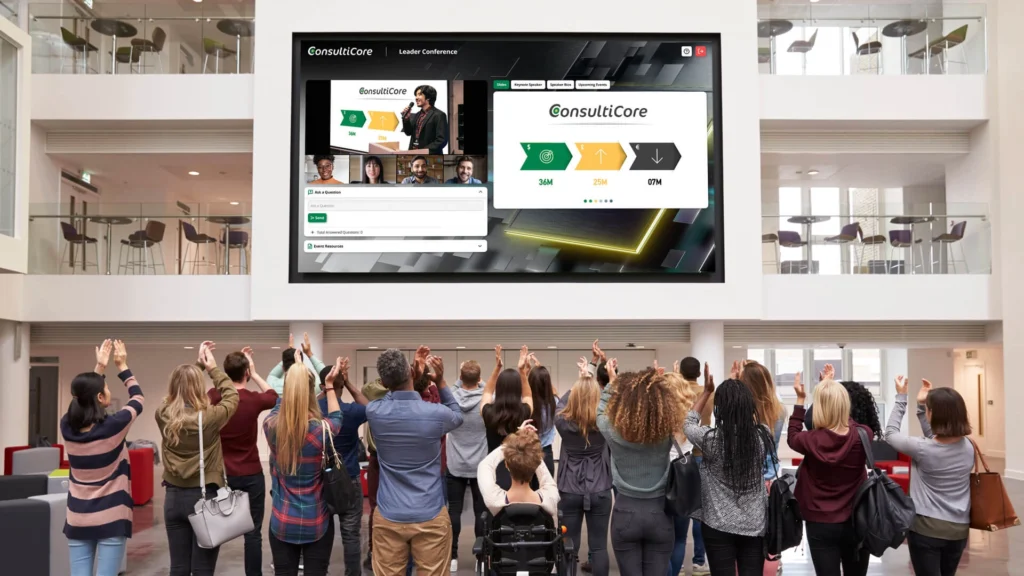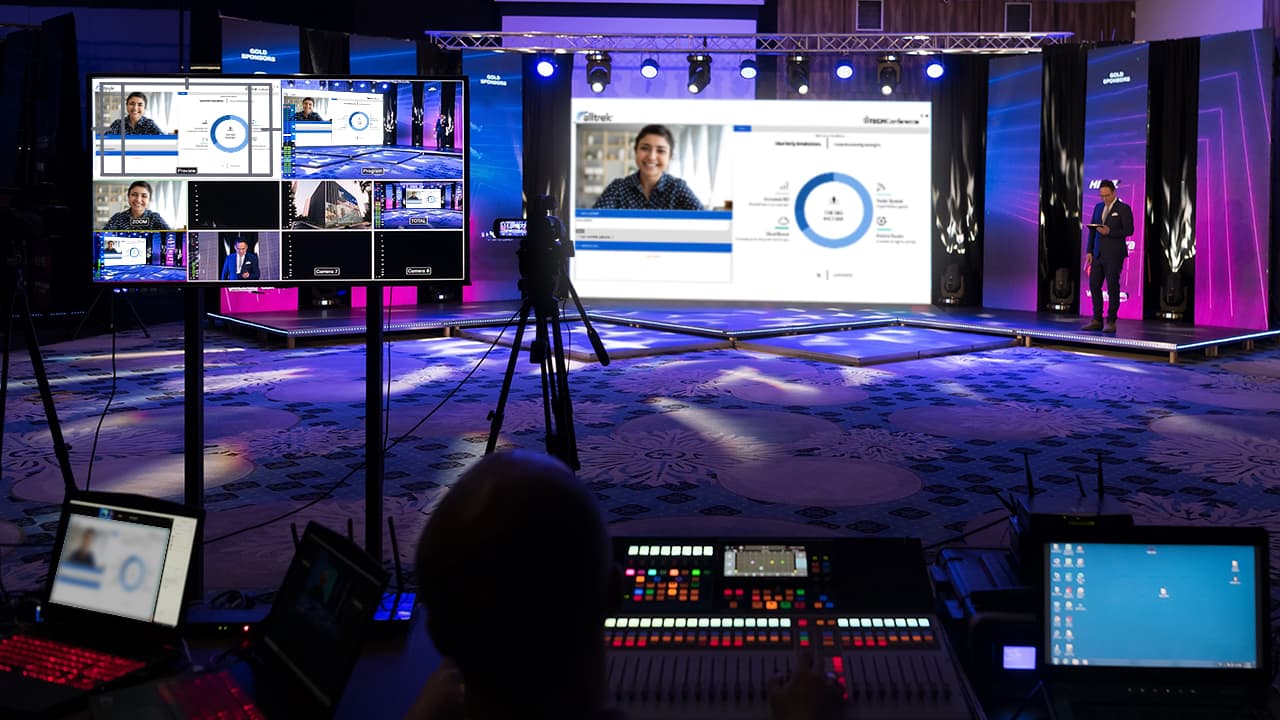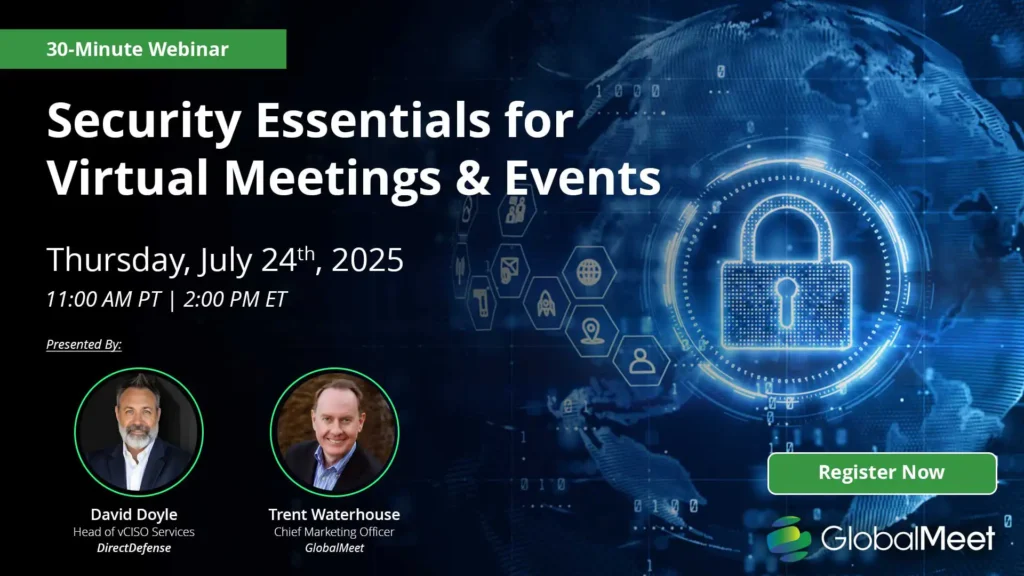
How to Host a Virtual Town Hall Meeting
- by GlobalMeet Blog Team
- ,
In today’s digital-first world, virtual town hall meetings have become a game-changer in corporate communication. They’re an ideal way to connect leadership with a distributed workforce, fostering a sense of community and transparency across any organization.
Whether you’re leading a Fortune 500 company or an emerging business, mastering the art of hosting effective virtual town halls can revolutionize your internal communications and align your teams with your company’s vision. Let’s dive into what makes these meetings tick, their benefits and how to host a virtual town hall meeting seamlessly with GlobalMeet.
In this comprehensive guide, we’ll cover:
- What are virtual town hall meetings?
- What goes on in virtual town halls?
- What are the benefits of virtual town halls?
- Virtual town hall agenda example
- How to host a virtual town hall meeting
- Town halls with GlobalMeet
What Are Virtual Town Hall Meetings?
A virtual town hall meeting is a digital evolution of the traditional town hall forum, adapted for the modern, interconnected corporate world. These meetings provide a virtual space where employees and management converge to exchange information, ideas and feedback. It’s a concept that transcends physical barriers, bringing together a dispersed workforce, from various departments and geographic locations, into a single, cohesive assembly.
The Dynamics of Virtual Town Halls
At its core, a virtual town hall is an interactive online event. Senior management and leaders utilize a virtual event platform to communicate company updates, policy changes and strategic directions. These meetings are designed for two-way communication. Employees are encouraged to engage in dialogues, pose questions and provide their insights, making these sessions an inclusive experience.
One of the unique aspects of virtual town halls is their ability to level the playing field. Unlike traditional in-person meetings where seating arrangements might create a hierarchy of visibility and engagement, virtual town halls offer every participant a ‘front-row’ experience. This setup fosters a sense of equality and encourages more open and balanced participation.
The Benefits of Going Virtual With Your Town Halls
Switching to virtual town halls offers several advantages over traditional, in-person gatherings:
- Cost-Effectiveness and Scalability: Virtual town halls eliminate the logistical challenges and costs associated with physical venues, travel, and accommodation. They are easily scalable, capable of accommodating anything from a small team to 100,000+ employees across the globe.
- Enhanced Engagement: Innovative digital tools, such as surveys, polling, Q&A, audience chat, social media feeds and dynamic layouts, transform passive listeners into active participants. These features enrich the experience and ensure higher engagement levels.
- Flexibility and Convenience: Participants can join from anywhere, be it their office, home, or on the move. This flexibility results in higher attendance and participation rates.
- Data and Feedback Collection: Virtual platforms enable the collection of valuable data, like engagement metrics and real-time feedback, helping organizations to gauge the effectiveness of their communication and make informed decisions for future meetings.
Incorporating GlobalMeet into Your Virtual Town Halls
While virtual town halls offer numerous advantages, their success heavily depends on the chosen platform’s capabilities. This is where GlobalMeet excels. Our platform is tailored to enhance your virtual town hall experience, providing advanced features and tools that make organizing and hosting these events straightforward and effective.
Whether you’re hosting a small internal meeting or a large-scale global event, GlobalMeet is equipped to handle your needs with ease. We offer robust security features to protect your discussions, flexible speaker options to accommodate multiple presenters and interactive elements to keep your audience engaged.
At GlobalMeet, we understand that every organization has unique needs. That’s why we offer both a webinar platform license and professionally managed event options, allowing you to choose the level of support that best fits your event.
What Goes On in Virtual Town Halls?
Virtual town halls are dynamic and multifaceted events that serve as a nexus for communication within an organization. Let’s break down the typical components and activities that make up these engaging digital assemblies.
Key Activities in Virtual Town Halls
Leadership Addresses
These meetings often commence with senior management, including CEOs and department heads, presenting the company’s current status, achievements, challenges and future plans. This segment sets the stage and provides context for the rest of the discussion.
Departmental Updates
Different departments or teams may present their updates, showcasing recent successes, ongoing projects, or future endeavors. This broadens employees’ understanding of the company’s diverse operations.
Interactive Q&A Sessions
A vital component of virtual town halls, Q&A sessions invite employees to ask questions via chat. With fully managed events, you can gain access to GlobalMeet’s Centerstage managed feature, where special guests cameo on video during a live event to ask a question or contribute to an ongoing discussion. This not only clarifies doubts but also fosters transparency and trust within the organization.
Polls and Surveys
Real-time polling and surveys are often conducted to gather instant feedback, gauge employee sentiments, or make collective decisions. This immediate interaction enhances engagement and makes employees feel valued.
Recognition and Awards
Acknowledging individual or team achievements during town halls boosts morale and motivates employees. It’s an opportunity to celebrate successes and reinforce positive behaviors aligned with company values.
Training and Development Opportunities
Sometimes, town halls include segments on professional development, where new training programs, learning resources, or career advancement opportunities are introduced.
Special Announcements
Virtual town halls are often used to make significant announcements such as mergers, acquisitions, or strategic shifts, ensuring that all employees receive this information instantaneously.
What are the Benefits of Virtual Town Halls?
Virtual town halls offer unique advantages that can significantly impact an organization’s communication strategy.
Enhanced Accessibility and Inclusivity
These meetings break down geographical barriers, allowing global participation. Employees from various locations can join, fostering a sense of unity and inclusion.
Data-Driven Insights for Improvement
With advanced analytics capabilities of platforms like GlobalMeet, organizations can gain insights into participant engagement and feedback, allowing for continuous improvement in their communication strategies.
Improved Communication and Transparency
Virtual town halls offer a platform for open dialogue between employees and management. This transparent communication helps in aligning the workforce with the company’s vision and goals.
Record and Replay Capabilities
Virtual town halls can be recorded, providing an opportunity for those who missed the live event to catch up, and for attendees to revisit key discussions.
Cost and Time Efficiency
By going virtual, companies save on the expenses and logistical complexities associated with physical events. This efficiency extends to attendees as well, who save time by joining from their preferred locations.
Interactive and Engaging Features
With tools like live polling, Q&A and chat functionalities, virtual town halls transform from passive listening experiences to interactive sessions.
Scalability and Flexibility
Whether it’s for a small team or an enterprise-wide gathering, virtual town halls can be scaled to fit any size, catering to hundreds or 100,000+ participants without compromising the quality of interaction.
Speak the Language of Your Customers, Investors and Employees
GlobalMeet builds an inclusive culture that breaks down language barriers, fosters team building and improves accessibility and inclusivity with live interpretations or captions during events.
In essence, virtual town halls, powered by robust platforms like GlobalMeet, are transforming corporate communication, making it more inclusive, engaging and effective. They are an indispensable tool in today’s fast-paced, globally dispersed corporate world.
Virtual Town Hall Agenda Example
Crafting an engaging agenda is key to a successful virtual town hall. Here’s an example agenda that leverages the capabilities of GlobalMeet’s solution.
Dynamic Kick-Off
- Introduction: Begin with a lively and engaging introduction. This could be a surprising fact, a thought-provoking question, or a brief, impactful story relevant to your organization’s current focus.
- Icebreaker Activity: Use GlobalMeet’s interactive features for a virtual icebreaker. This could be a quick poll, a fun trivia question about the company, or a creative visual puzzle to get everyone’s gears turning.
Company Insights and Updates
- Company Overview: Present an overview of the company’s recent achievements and current status. Utilize GlobalMeet’s high-quality video and slide-sharing capabilities to present engaging visuals.
- Departmental Highlights: Have department heads share their latest updates, achievements, and upcoming projects. This segment can include short video clips or interactive graphics to maintain audience interest.
- Milestone Celebrations: Acknowledge any significant company milestones, anniversaries, or awards, enhancing the sense of community and shared success.
Interactive Q&A Session
- Open Forum: Utilize GlobalMeet’s Centerstage Managed Feature to allow employees to ask questions on video. This session is moderated to ensure a smooth flow of conversation.
- Live Polling: Conduct live polls during the Q&A to gauge employee opinions on key topics or to make decisions on lighter, more engaging subjects.
Engaging, Accessible Activities
- Guest Speaker or Workshop: If applicable, include a segment with a guest speaker or a brief workshop on a topic of interest, such as mindfulness or professional development.
- Speak the Language: GlobalMeet’s language captions and live interpreters break down language barriers, fostering accessible, credible and effective global communication.
Forward-Looking Statements
- Future Goals and Objectives: Share the company’s vision for the upcoming quarter or year. This is an opportunity to align everyone with the organization’s future direction.
- Announcements of Upcoming Events: Inform the employees about upcoming events, training sessions, or town halls, creating anticipation and ensuring continued engagement.
Inspirational Conclusion
- Motivational Close: End the town hall on a high note. This could be a positive message from the CEO, a highlight reel of employee achievements, or an inspiring story that resonates with the company’s values.
- Feedback Request: Encourage participants to provide feedback on the town hall via GlobalMeet’s survey tool, emphasizing the importance of their opinions in shaping future meetings.
How to Host a Virtual Town Hall Meeting
Organizing a successful virtual town hall meeting can significantly impact your company’s internal communication and employee engagement. Here’s how to host a virtual town hall meeting that leaves a lasting impression on your audience.
- Establish Clear Goals
When it comes to hosting a virtual town hall meeting, defining your purpose is the first and crucial step. Are your goals centered around corporate updates, boosting employee engagement, or conveying strategic announcements? Understanding your audience is equally important. Determine whether you’re addressing the entire organization, certain departments, or a combination of internal and external stakeholders.
- Scheduling and Familiarization
Scheduling your virtual town hall meeting is a critical aspect, especially if your audience spans multiple time zones. Familiarize yourself with all the features that GlobalMeet offers, ensuring you leverage its full potential for effective streaming and engaging audience interaction.
- Content Preparation
A well-crafted agenda is essential for a successful virtual town hall. Outline all the topics and segments in your agenda and share them with attendees in advance. This approach sets clear expectations and helps in keeping the meeting structured. Conduct rehearsals for all speakers using GlobalMeet’s tools to ensure they are comfortable with both the technology and their content delivery.
- Technical Readiness
Make sure to conduct a thorough check of all technical elements, like audio and video quality, before the event. Preparing GlobalMeet’s interactive features such as Q&A, polling and chats in advance will enhance audience participation and engagement during the town hall.
- Execution of the Town Hall
Start your virtual town hall meeting punctually, respecting your attendees’ time. Engage your audience by utilizing GlobalMeet’s interactive tools and maintaining a dynamic and interactive presentation style. Adhering to the agenda is important, but remain adaptable to accommodate any real-time audience interactions or discussions that may arise.
- Post-Event Engagement
Post-event engagement is crucial. Share the recording of the town hall with those who couldn’t attend using GlobalMeet’s recording feature. Collecting feedback through surveys after the event is crucial in gathering insights to refine and improve future virtual town halls.
- Review and Improvement
Finally, review and improve your town hall meetings by analyzing engagement through GlobalMeet’s reporting and analytics. Understanding attendee behaviors and engagement levels is key. Use the feedback and data insights you collect for continuous improvement, ensuring each virtual town hall is more impactful than the last.
Learning how to host a virtual town hall meeting involves careful planning, leveraging the right tools, and engaging with your audience effectively. With GlobalMeet, you’re equipped to transform your town halls into memorable experiences for every participant.
Host a Virtual Town Hall with GlobalMeet
Each virtual town hall is an opportunity to align your workforce with your company’s vision and goals, making every employee feel valued and heard. Don’t let technical glitches or logistical challenges hinder your next big event. Connect with us today or schedule a demo and take the first step towards transforming your virtual events into impactful experiences.
Leveraging Virtual Events for Enhanced Corporate Communication
- by GlobalMeet Blog Team
- ,
As your organization gears up for the upcoming Quarterly Business Review or All-Hands Meeting, shifting to a virtual event platform has its perks, especially in the context of remote work. Embracing webcasts for corporate communication can simplify the process, whether you’re addressing a group of 100 or 100,000+ employees or customers.
Confidence in Your Agenda and Presentation
For a high-stake corporate webcast, project confidence and enthusiasm about your content, setting the tone for an engaging and informative presentation. Each speaker should prepare notes and talking points in advance, ideally with a practice run or two, ensuring a smooth and polished delivery. If department heads are sharing their teams’ quarterly achievements and challenges, ensure they are well-prepared to handle any questions that may arise.
Facilitating Audience Interaction
In the world of corporate communication, it’s not just about delivering information; it’s about engaging your remote audience effectively. To achieve this, consider incorporating multimedia elements into your webcasts, such as video clips, images, and dynamic graphics, to make your presentations more visually appealing. It’s also important to encourage participation through real-time polls and surveys, allowing your audience to express their opinions and providing valuable insights for your organization.
Moreover, don’t underestimate the importance of post-virtual event engagement. After your corporate event, share the recorded webcast with your audience, making it accessible for those who couldn’t attend live. Provide follow-up space for ongoing discussion and questions, allowing employees or stakeholders to continue the conversation, share feedback, and build a sense of community. These interactive experiences and ongoing engagement can enable your webcasts to become a powerful tool for fostering meaningful connections in a remote work environment. GlobalMeet offers the flexibility and features to help you in this journey, making your corporate communication more effective and inclusive than ever before.
Adapting Your Tone to Different Audiences
Whether your presentation is directed towards employees, investors, customers, partners, or a board, it’s important to customize your approach. While the core content, such as presenting sales figures and growth, may remain consistent, your tone should cater to the specific audience. Investor presentations may require a more formal and polished tone, while employee briefings might adopt a somewhat more casual demeanor. Ensure that your tone and delivery match the intended audience in corporate communication.
Elevating Corporate Communication Webcasts
GlobalMeet Webcast streamlines corporate communication in a remote work environment, offering both self-service and managed event services so you can focus on delivering your message, not the technology. With the ability to brand your webcast for a cohesive company identity, you can create a structured online experience. Features like audience polling and Q&A sessions promote meaningful interaction. A customized, branded experience allows for a controlled company identity and creates a structured experience online, while audience polling and Q&A features allow for appropriate interaction.
To access comprehensive instructions on creating a professional webcast experience for your upcoming corporate town hall, business review, board meeting, or all-hands meeting, download GlobalMeet’s Virtual Event Planning Guide today. For more information on how GlobalMeet can enhance your corporate communication efforts, contact our sales team today.

Effective Crisis Communication Strategies in 2024
- by GlobalMeet Blog Team
- ,
In the world of business, crises are an unfortunate reality. Despite prior proper planning, they can strike at any time. Statistics reveal that 69% of business leaders have encountered a crisis in the past five years, ranging from negative press articles and product recalls to quality issues, financial setbacks, or even natural disasters. Regardless of how it forms, being well-prepared for a crisis is essential. In such situations, emotions can run high, and panic can quickly set in, potentially exacerbating the problem. This is precisely why having a well-thought-out crisis communication strategy is critical.
Understanding Crisis Communications
Crisis communication is the action of disseminating information during unfavorable events. This information may need to reach employees, investors, the board, customers, or any other stakeholders affected by the crisis. A well-structured crisis communication strategy plays a pivotal role for several reasons:
- Advance Preparation: It enables teams to agree on a course of action in advance, ensuring quick and confident communication when a crisis occurs.
- Reputation Protection: It helps prevent irreparable damage to your business’s reputation.
- Employee Assurance: It allows customer-facing teams to communicate with the public, assuring a sense of security among employees.
Best Crisis Communication Strategies in 2024
Surprisingly, only 23% of organizations feel that their crisis communication plans are fully integrated into the company, and a staggering 95% of business leaders acknowledge the need for improvement in their crisis management capabilities. This displays the necessity for more comprehensive plans and strategies from leadership. Here are four best crisis communication strategies for 2024:
1. Develop a Comprehensive Playbook
Your crisis communication plan should begin with a playbook that outlines key elements such as the response team, frequently asked questions, contact information, chain of command, product management workflows, legal guidelines, and more. Seek approval for these fundamentals in advance and ensure the playbook is regularly updated.
2. Appoint a Single Media Contact
When engaging with the press or media during a crisis, clarity and consistency in messaging are crucial. Multiple team members or executives speaking to the media can create conflicting messages. Hence, a single point of contact for media communication is necessary, whether it’s the CEO, COO, or a PR professional. Be sure to voice the importance of directing all press inquiries to the designated person and refraining from responding without approval. Deloitte’s findings highlight vulnerabilities in corporate reputation, cybercrime, and rumors, making this practice all the more important.
3. Practice and Maintain Composure
While easier said than done, rehearsing crisis responses helps maintain composure when a real crisis unfolds. Involve all relevant stakeholders in mock crisis scenarios and conduct post-analysis to identify strengths and weaknesses. What aspects of your plan need improvement? What questions emerged? Where did clarity or confidence waver during the process? Address these areas, and when a crisis strikes, remember that you have prepared for this moment.
4. Emphasize Clear Communication
Having a prepared message and a single, authoritative voice addressing customers, investors, the media, and the public is a significant advantage. Utilize webcasts for crisis communication, as they offer a convenient, user-friendly medium. Regardless of the audience, high-quality video and audio enhance content delivery. By rehearsing your plan with the support of GlobalMeet for communication, you can rest assured that your business is well-prepared for the inevitable challenges that lie ahead. Contact our sales team today to learn more.

Strategic Corporate Communications with Webcasts
- by GlobalMeet Blog Team
- ,
Whether you’re hosting a sales and marketing town hall, an executive briefing, investor relation events, or an annual insurance and benefits update, corporate communications is critical in building strong relationships with diverse audiences. However, traditional corporate communication can often feel impersonal and cold and leaves much to be desired. Modern audiences and companies want to create a warm, personal connection with customers and partners, and webcasts are one of the best ways to do that.
Here are a few ways to create more strategic, personalized corporate communications with webcasting technology:
1. Use Dynamic, Engaging Video
One-dimensional technology like emailing or chatting can create misunderstandings due to the lack of body language, tone of voice, inflection, and other verbal communication signals. It can also feel cold and impersonal. GlobalMeet Webcast powers crystal-clear, high-definition audio and video webcasting technology and makes it easy to dynamically switch speaking layouts. As a result, attendees won’t get bored with the same screen over and over again, and their attention can be drawn to a specific message.
2. Maintain a Reliable Connection
Nothing is worse than getting all of your employees and contractors prepped for a meeting or town hall only to have the broadcast fail on you. Attendees will quickly lose interest, even if it’s just a few seconds of delay or lag. Instead, use a reliable webcasting platform that is “always on” and is known for its stability.
3. Ensure Your Webcasting Platform Is User-Friendly
Easily share slides and videos, quickly take audience polls, and answer attendees’ chat questions so they feel listened to and more engaged. A user-friendly webcasting platform encourages teams to share more and reduces the significant amount of friction that people experience when they hop on video.
4. Analyze Robust Data
Data tells the story of how successful your live webcast was. Integrated analytical data and reporting eliminate the guesswork and transparently show you what portions can be optimized for a better response from the audience. You can also analyze on-demand recordings and gather analytics on how those attendees watched and engaged with the presentation. This helps you optimize the time, date, and format of future webcasts to meet the needs of employees better.
Why GlobalMeet Webcast for Corporate Communications?
GlobalMeet Webcast is the solution of choice for many of the Fortune 500 around the globe. Powerful webcasting technology helps your business meet its organizational goals and addresses many of the communication pain points when it comes to communicating with a vast, diverse workforce. Learn more today.





